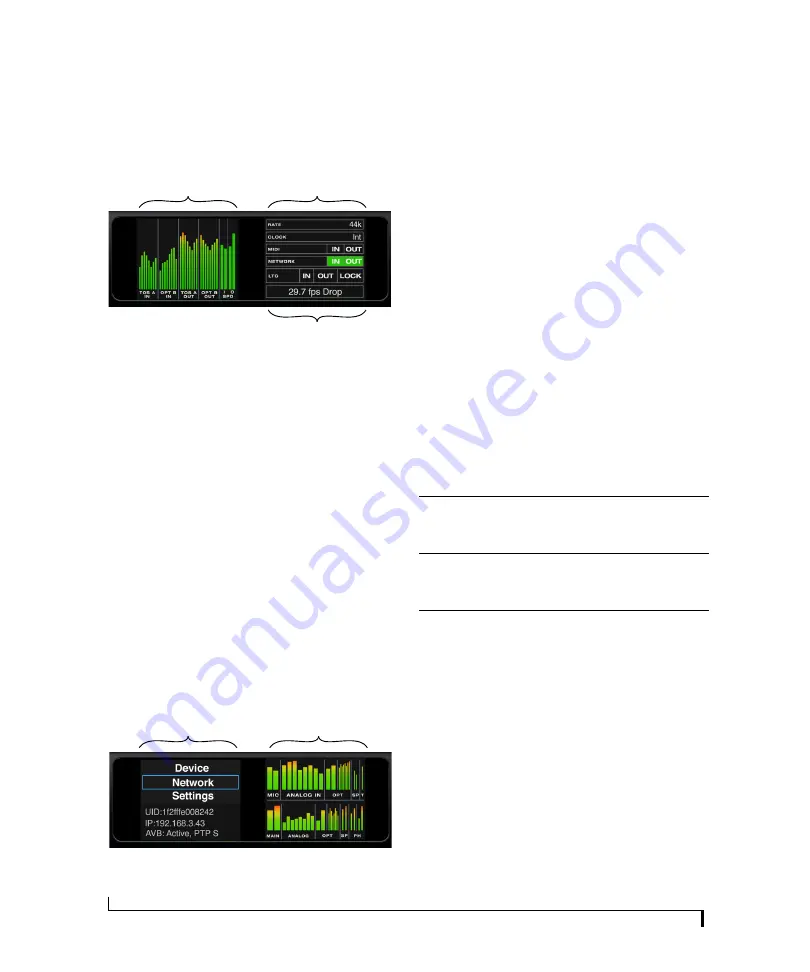
F R O N T P A N E L O P E R A T I O N
58
Screen set C
Screen set C (Figure 7-4) shows metering for all
optical and S/PDIF digital I/O, system settings and
time code settings.
Figure 7-4: Screen set C.
Sample rate and clock source
The sample rate and clock source section of the
LCD (Figure 7-2 on page 57) displays the sample
rate at which the unit is currently operating (item
#8 in the Devices tab on page 12), and the current
Clock Mode setting (item #13 on page 12). The
Clock Mode setting can also be found (and
changed) in the Settings Menu.
Time code settings
For more information about the time code settings
shown in Figure 7-4 on page 58, see “Syncing to
SMPTE time code (LTC)” on page 48.
MENU NAVIGATION
Push the MENU knob to access the menu, which
provides settings and status information
(Figure 7-5).
Figure 7-5: Menu navigation.
Turn the MENU knob to scroll through the menu.
Push MENU to enter the selected sub-menu or to
select the currently highlighted setting.
A currently selected setting flashes. Turn the
MENU knob to change the setting, and push it to
confirm the change, or push BACK to cancel the
change and exit.
Push BACK to return to the previous menu item.
To exit the menu, push METERS.
Device
The Device menu item provides information
about the device, such as its name and connection
mode (Thunderbolt, USB or AVB).
Network
The Network menu item displays the following
network-related information:
Sample rate, clock source,
MIDI and network activity
Metering for optical
and S/DIF digital I/O
Time code settings
Menu
Meter overview
Setting
Explanation
Serial/UID
Unique AVB network identifier and serial
number that can be used for troubleshooting
and registering your device at motu.com/
register.
IP address
The unique network address for the unit.
Type this address into your web browser to
access the unit’s settings in the MOTU Pro
Audio Control web app.
AVB
Indicates whether AVB networking is
currently enabled or disabled. For example,
AVB could be disabled because a non-AVB
switch is being used. When AVB is disabled,
audio streaming over the network is disabled.
Summary of Contents for 828es
Page 5: ...Part1 GettingStarted...
Page 6: ......
Page 8: ...8...
Page 22: ...M O T U P R O A U D I O C O N T R O L W E B A P P 22...
Page 28: ...P A C K I N G L I S T A N D S Y S T E M R E Q U I R E M E N T S 28...
Page 32: ...S O F T W A R E I N S T A L L A T I O N 32...
Page 51: ...Part2 Usingthe828es...
Page 52: ......
Page 62: ...F R O N T P A N E L O P E R A T I O N 62...
Page 78: ...M I X E R E F F E C T S 78...
Page 94: ...M O T U A U D I O T O O L S 94...
Page 101: ...Part3 Appendices...
Page 102: ......
Page 108: ...A P P E N D I X B A U D I O S P E C I F I C A T I O N S 108...
Page 109: ...APPENDIX 109 C Mixer Schematics MONO INPUT CHANNEL...
Page 110: ...A P P E N D I X C M I X E R S C H E M A T I C S 110 STEREO INPUT CHANNEL...
Page 111: ...A P P E N D I X C M I X E R S C H E M A T I C S 111 GROUP BUS...
Page 112: ...A P P E N D I X C M I X E R S C H E M A T I C S 112 MONITOR BUS...
Page 116: ...A P P E N D I X E O S C S U P P O R T 116...
Page 120: ...I N D E X 120...






























